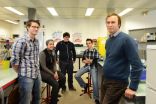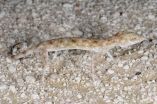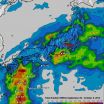(Press-News.org) Two years ago, Prof. Eshel Ben-Jacob of Tel Aviv University's School of Physics and Astronomy and Rice University's Center for Theoretical Biological Physics made the startling discovery that cancer, like an enemy hacker in cyberspace, targets the body's communication network to inflict widespread damage on the entire system. Cancer, he found, possessed special traits for cooperative behavior and used intricate communication to distribute tasks, share resources, and make decisions.
In research published in the Early Edition of the Proceedings of the National Academy of Sciences, Prof. Ben-Jacob and researchers from Rice University and the University of Texas M.D. Anderson Cancer Center, the leading cancer treatment center in the U.S., offer new insight into the lethal interaction between cancer cells and the immune system's communications network. Prof. Ben-Jacob and the study co-authors developed a computer program that models a specific channel of cell-to-cell communication involving exosomes (nanocarriers with crucial cellular "intelligence") that both cancer and immune cells harness to communicate with other cells.
"Recent research has found that cancer is already adept at using a kind of 'cyberwarfare' against the immune system. We studied the interplay between cancer and the immune system to see how we might be able to shift the balance against cancer," said Prof. Ben-Jacob, noting a difference between the innate and the adaptive qualities of the immune system. "In the beginning, cancer is inhibited by the body's innate immunity. But once cancer escapes the immunity, there is a race between the progression of cancer and the ability of the adaptive immune system to recognize and act against it."
Cyberwarfare of the body
"What we are dealing with is cyberwarfare, pure and simple. Cancer uses the immune systems' own communications network to attack not the soldiers but the generals that are coordinating the body's defense," said Prof. Ben-Jacob.
To better understand the role of exosome-mediated cell-to-cell communication in the battle between cancer and the immune system, the researchers created a computer model that captured the exosomal exchange between cancer cells, dendritic cells, and the other cells in the immune system.
The new model is based on earlier research, which showed that dendritic cells, mediators between the body's innate and adaptive immune systems (the former protects against all threats at all times and the latter guards more efficiently against specific, established dangers), employed exosomes to fulfil their task. The researchers discovered that, overtaken by cancer, these nanocarriers, which contain such vital components as signaling proteins, RNA snippets, and microRNAs, can command cells to change their tasks, placing the entire system at risk.
Finding a better balance between the strong and the weak
According to the new research, three possible cancer states can exist: strong, intermediary, and weak. The intermediary state — in which cancer is neither strong nor weak and in which the immune system is on high alert — could be the key to a new therapeutic approach with reduced side effects. Prof. Ben-Jacob believes it is possible to force cancer from a strong to moderate state, and then from a moderate to weak state, by alternating cycles of radiation or chemotherapy with immune-boosting treatments.
"Our first important discovery is that this situation is due to the exosome-based cyberwar between cancer and the immune system," said Prof. Ben-Jacob. "Without exosomes, the two possible states are only strong-weak and weak-strong. With exosomes, an intermediary state opens a new way to treat cancer using very a different approach."
Prof. Ben-Jacob likened the exchange to a tug-of-war between cancer and the immune system. "The challenge is to be familiar with the battlefield so that we can manipulate cancer therapies to change the balance in favor of the immune system. When cancer is detected, it is almost always in the context of a cancer-immunity competition," said Prof. Ben-Jacob. "We showed that the way to stop and reverse tumor progression without causing strong side effects is an individualized approach of mixed treatments — i.e., four days of radiation followed by a few days of immune system boosting, followed again by four days of radiation, and so on. If provided in the right order, the treatments could indeed shift the balance toward the immune system's 'victory' in reducing the cancer to the moderate-strong state."
INFORMATION:
The study was supported by the Cancer Prevention and Research Institute of Texas, the National Science Foundation, and the Tauber Family Funds.
American Friends of Tel Aviv University supports Israel's leading, most comprehensive and most sought-after center of higher learning, Tel Aviv University (TAU). Rooted in a pan-disciplinary approach to education, TAU is internationally recognized for the scope and groundbreaking nature of its research and scholarship — attracting world-class faculty and consistently producing cutting-edge work with profound implications for the future. TAU is independently ranked among the world's top universities and #1 in Israel. It joins a handful of elite international universities that rank among the best producers of successful startups.
NOAA's GOES-West satellite took a picture of Tropical Storm Simon weakening over Mexico's Baja California.
On Oct. 7, a Tropical Storm Watch was in effect for Punta Abreojos to Punta Eugenia, Mexico. The National Hurricane Center expects Simon to produce storm total rainfall amounts of 3 to 5 inches with isolated amounts around 8 inches through Wednesday, Oct. 8, across northern portions of the Baja California Peninsula and the state of Sonora in northwestern Mexico. Over the next few days, storm total rainfall amounts of 1 to 2 inches with isolated amounts of around ...
Eating disorders (ED) such as anorexia nervosa, bulimia, and binge eating disorder affect approximately 5-10% of the general population, but the biological mechanisms involved are unknown. Researchers at Inserm Unit 1073, "Nutrition, inflammation and dysfunction of the gut-brain axis" (Inserm/University of Rouen) have demonstrated the involvement of a protein produced by some intestinal bacteria that may be the source of these disorders. Antibodies produced by the body against this protein also react with the main satiety hormone, which is similar in structure. According ...
A new study led by Professor Kui Liu at the University of Gothenburg has identified the key molecule 'Greatwall kinase' which protects women's eggs against problems that can arise during the maturation process.
In order to be able to have a child, a woman needs eggs that can grow and mature. One of these eggs is then fertilised by a sperm, forming an embryo. During the maturation process, the egg needs to go through a number of stages of reductional division, called meiosis. If problems occur during any of these stages, the woman can become infertile. Around 10-15% of ...
The Gulf Sand gecko is a remarkable desert reptile in that it is the only lizard found habitually on sabkha substrate across large parts of the eastern Arabian Peninsula. These arid salt flats constitute one of the harshest habitats on earth, due to their extraordinary salinity.
The Gulf gecko, Pseudoceramodactylus khobarensis, belongs to a genus with a single species, and it is well adapted to this substrate featuring spiny scales beneath the fingers, long extremities and swollen nostrils.
Data on its distribution range showed a conspicuous gap between eastern United ...
October 7, 2014 – For women undergoing breast reconstruction using the advanced "DIEP" technique, a simple formula can reliably tell whether there will be sufficient blood flow to nourish the DIEP flap, reports a paper in Plastic and Reconstructive Surgery—Global Open®, the official open-access medical journal of the American Society of Plastic Surgeons (ASPS).
Drs Joseph Richard Dusseldorp and David G. Pennington of Macquarie University Hospital, Sydney, performed an ultrasound study to see how well the flap viability index (FVI) equation predicted blood ...
DETROIT – The only drug currently approved for treatment of stroke's crippling effects shows promise, when administered as a nasal spray, to help heal similar damage in less severe forms of traumatic brain injury.
In the first examination of its kind, researchers Ye Xiong, Ph.D, Zhongwu Liu, Ph.D., and Michael Chopp, Ph.D., Scientific Director of the Henry Ford Neuroscience Institute, found in animal studies that the brain's limited ability to repair itself after trauma can be enhanced when treated with the drug tPA, or tissue plasminogen activator.
"Using this ...
Undergoing an experience with another person — even if we do it in silence, with someone we met just moments ago — seems to intensify that experience, according to new research published in Psychological Science. The research shows that people who share experiences with another person rate those experiences as more pleasant or unpleasant than those who undergo the experience on their own.
"We often think that what matters in social life is being together with others, but we've found it also really matters what those people are doing," says psychological scientist ...
Typhoon Phanfone packed heavy rainfall as it brushed over Japan and NASA's TRMM satellite identified where the rain fell. That data was used to make a map of rainfall totals.
The Tropical Rainfall Measuring Mission or TRMM satellite has the ability to calculate rainfall rates within storms as it orbits around the Earth's tropics from space. TRMM data can also be used to create rainfall maps that show how much rain has fallen over given areas.
Phanfone was a powerful super typhoon with sustained wind speed estimated at 130 knots (150 mph) as it approached Japan but ...
Being the center of attention can have its drawbacks. For female chimpanzees, being around too many rowdy males is disadvantageous when foraging for food, an effect that can ultimately interfere with her reproductive ability. These are some of the findings of an 11-year-long study of wild East African chimpanzees in Uganda, led by Melissa Emery Thompson of the University of New Mexico in the US. It is published in Springer's journal Behavioral Ecology and Sociobiology.
Female chimpanzees have an exceedingly slow reproductive schedule, and only give birth every five to ...
New Rochelle, NY, October 7, 2014—Low sexual desire is common among both pre- and post-menopausal women. It can cause personal distress, harm relationships, and have a negative impact on body image and self confidence. Yet few women seek medical care for this condition, and the reasons are explored in a timely article in Journal of Women's Health, a peer-reviewed publication from Mary Ann Liebert, Inc., publishers. The article is available free on the Journal of Women's Health website at http://online.liebertpub.com/doi/full/10.1089/jwh.2014.4743 until November 7, ...






